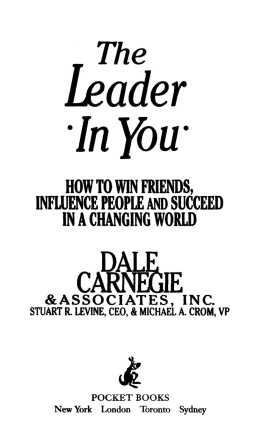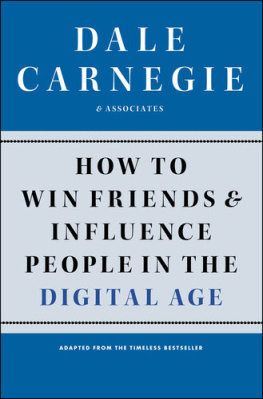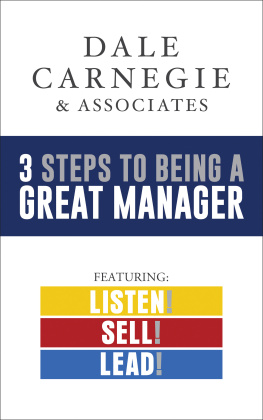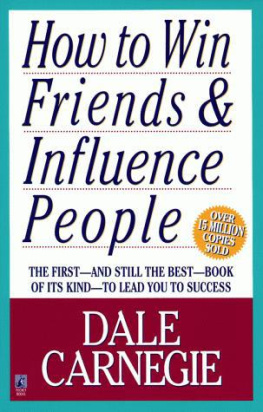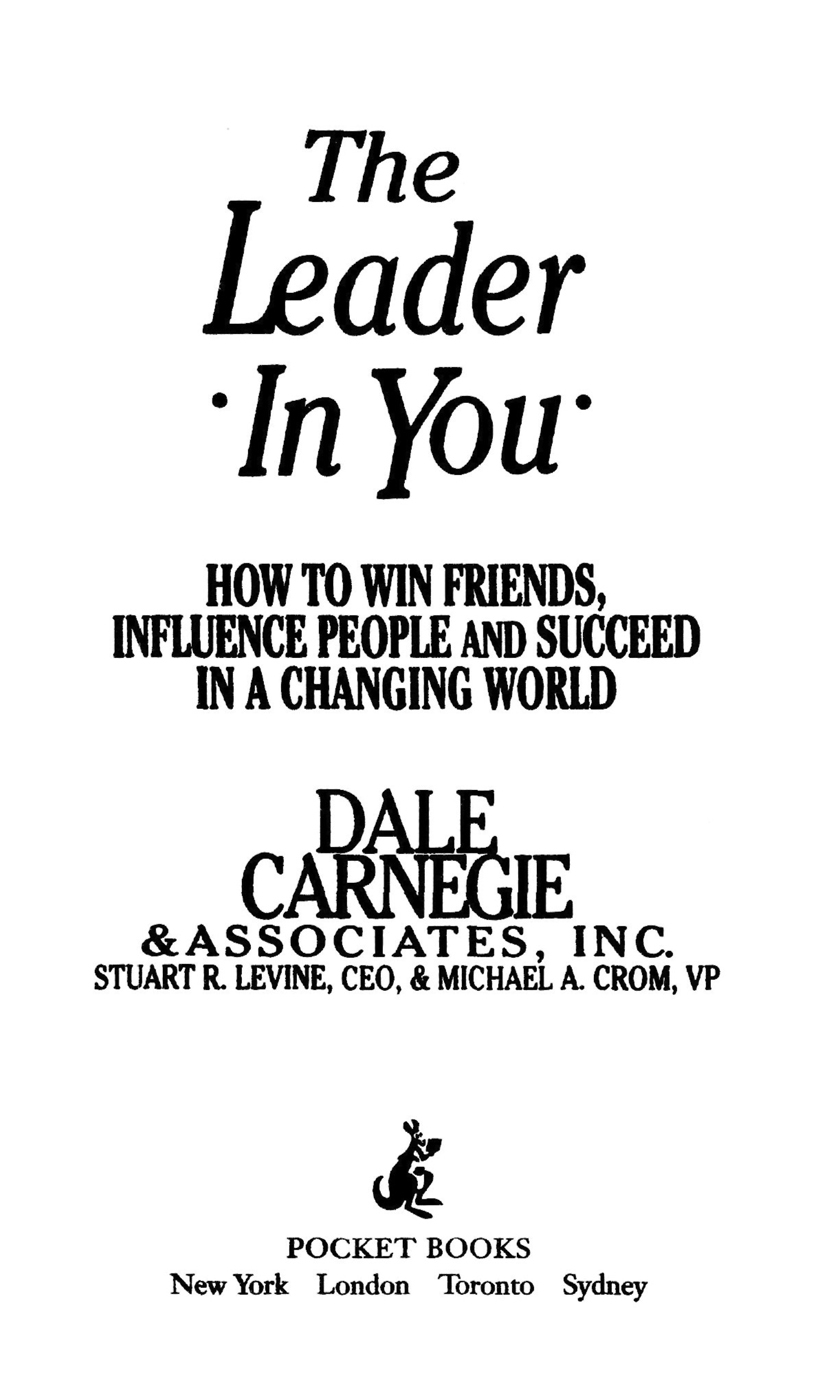Want to Take Charge?
Read What Business Leaders
Say About
THE LEADER IN YOU
Nothing in this book is complicated, mysterious, or difficult. But it can make you a leader in a complicated, difficult, and sometimes mysterious world. Leadership is the key to success.
Burt Manning, Chairman and CEO,
J. Walter Thompson
Following the Dale Carnegie tradition, this book shows how easy and simple it is for people to develop the gift of effective leadership that most were born with. Its must reading for todays business people who want to turn uncertainty into career success.
Dr. Irwin L. Kellner, Chief Economist,
Chemical Banking Corp.
An unparalleled opportunity to learn from the best: true champions from all fields sharing their personal stories and proven strategies for success. I give this book a perfect 10!
Mary Lou Retton
Leadership is the ability to get people to do the right things at the right time with conviction and enthusiasm. Inspiring, readable, and enormously useful, THE LEADER IN YOU shows how to develop your leadership potential, no matter what your present job may be.
Laurent Bosson, President and CEO,
SGS-Thomson Microelectronics, Inc.
Books by Dale Carnegie
How to Develop Self-Confidence and Influence People by Public Speaking
How to Enjoy Your Life and Your Job (Revised Edition)
How to Stop Worrying and Start Living
How to Win Friends and Influence People (Revised Edition)
The Quick and Easy Way to Effective Speaking
By Dale Carnegie & Associates, Inc.
The Leader in You
Published by POCKET BOOKS
Thank you for purchasing this Pocket Books eBook.
Join our mailing list and get updates on new releases, deals, bonus content and other great books from Pocket Books and Simon & Schuster.
C LICK H ERE T O S IGN U P
or visit us online to sign up at
eBookNews.SimonandSchuster.com
CONTENTS
For our childrenJesse Levine, Elizabeth Levine, and Nicole Crom, whose fathers were far too distracted for far too long
And for our wivesNancy Crom, whose supportive spirit never faded, and Harriet Levine, whose energy and organizational genius helped bring this book to life
INTRODUCTION
The Human-Relations Revolution
Keep your mind open to change all the time. Welcome it. Court it. It is only by examining and reexamining your opinions and ideas that you can progress.
D ALE C ARNEGIE
As the twenty-first century approaches, the world is undergoing enormous change, a process of great upheaval and great possibility. In just a few short years, we have witnessed the dawn of postindustrial society, the advent of the information age, the rush to computerization, the birth of biotechnology, and not the least of these changes, the human-relations revolution.
With the end of the cold war, the business environment has grown dramatically more intense. Competition has become more global and more energized. And technology races on. No longer can businesses safely ignore their customers wants and needs. No longer can managers simply issue orders and expect them to be mindlessly obeyed. No longer can personal relationships be taken for granted. No longer can companies be less than obsessed with constant quality improvement. No longer can so much human creativity go so scandalously untapped.
To survive in the years to come, successful organizationsin business, in government, in the nonprofit worldwill have to undergo a profound cultural change. Their people will have to think quicker, work smarter, dream wilder, and relate to each other in very different ways.
Most important of all, this cultural change will require a whole new breed of leader, a leader quite unlike the bosses most of us have worked for and some of us have perhaps become. The day has long since passed when a company could be run with a bullwhip and a chair.
The leaders of tomorrow will have to establish a real vision and a sense of values for the organizations they wish to lead. These leaders will have to communicate and motivate far more effectively than did leaders of the past. They will have to keep their wits about them through conditions of near-constant change. And these new leaders will have to mine every ounce of talent and creativity that their organizations possessfrom the shop floor to the executive suite.
The roots of all this upheaval can be traced back to the decades that followed World War II. In the postwar years American companies seemed to prosper almost regardless of what they did. The economies of Europe and Asia were hobbled by the wars destruction, and the worlds developing countries were not much of an economic factor yet. Big American-based companies, backed by big labor and big government, set the standards for everyone else. It wasnt that these companies were so beautifully run. They never really had to be. With their steep hierarchies, their rigid job descriptions, and their we-know-best attitudes, they cruised right through the middle years of the centuryfat, happy, and as profitable as could be.
What lovely cocoons these companies provided for their employees! A job with a decent corporation was for many people a job for lifenot so different from the civil service, but with a better salary and sweeter fringe benefits.
Layoffs? Who ever heard of layoffs for people who wore suit jackets or dresses to work? Maybe for factory workers, but definitely not for the managerial set. People spoke often about the ladder of success, and thats how they would progress in their careers, one rung at a time, neither slower nor faster than the people above or below. In hindsight we see that those were the days of easy affluence; eventually they had to end.
While America was enjoying the fruits of the postwar era, the Japanese were thinking ahead. Their economy was destroyed, much of their basic infrastructure was in ruins, and that was just the beginning of what the Japanese had to overcome. They also had a worldwide reputation for producing cheap, shoddy goods and delivering second-rate customer service.
But after all the hardship they had suffered, the Japanese were ready to learn from their mistakes. So they went out and hired the best advisors they could find, among them Dr. W. Edwards Deming, a statistician who had worked in the United States Armys quality control office during the war.
Demings message to the Japanese: Dont try to copy the intricate structures of big American corporations. Instead, Deming and others advised, build a new kind of Japanese companya company dedicated to employee involvement, quality improvement, and customer satisfactionand work to unite all the employees behind those goals.
It didnt happen overnight, but the Japanese economy was reborn. Japan became a leader in technological innovation, and the quality of Japanese goods and services soared. With this new spirit in place, Japanese firms didnt just catch up with their foreign competitors. In many important industries, the Japanese rolled right past. It didnt take long for their approach to begin spreading around the globeto Germany, to Scandinavia, across the Far East, and along the Pacific Rim. America, unfortunately, was one of the last to catch on. This delay proved costly.
Slowly, imperceptibly at first, Americas cruise of easy affluence was running out of gas. Through the 1960s and the 1970s, the roar of the postwar economy was loud enough to drown out the occasional sputters, but the hints of trouble grew increasingly hard to ignore.
Oil got expensive. Inflation and interest rates shot up. And competition wasnt coming only from a reinvigorated Japan or Germany anymore. Dozens of other countries overseas, little blips on the economic landscape, suddenly arrived at the cutting edge of technology with newly sharpened competitive skills. Before long they too were capturing major market shares from General Motors, from Zenith, from IBM, from Kodak, and from other slumbering corporate giants.
Next page
